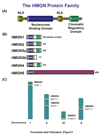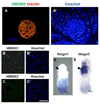Developmental function of HMGN proteins
- PMID: 20123069
- PMCID: PMC2818498
- DOI: 10.1016/j.bbagrm.2009.11.011
Developmental function of HMGN proteins
Abstract
High mobility group N (HMGN) proteins are the only nuclear proteins known to specifically recognize the generic structure of the 147-bp nucleosome core particle. Both in vitro and in vivo experiments demonstrate that HMGN proteins are involved in epigenetic regulation by modulating chromatin structure and levels of posttranslational modifications of nucleosomal histones. Expression of HMGN proteins is developmentally regulated, and the loss or overexpression of these proteins can lead to developmental abnormalities. This review will focus on the role and on the possible molecular mechanism whereby HMGN proteins affect cellular differentiation and development.
Published by Elsevier B.V.
Figures



References
-
- Bustin M. Chromatin unfolding and activation by HMGN(*) chromosomal proteins. TrendsBiochem Sci. 2001;26:431–437. - PubMed
-
- Rochman M, Postnikov Y, Correll S, Malicet C, Wincovitch S, Karpova TS, McNally JG, Wu X, Bubunenko NA, Grigoryev S, Bustin M. The interaction of NSBP1/HMGN5 with nucleosomes in euchromatin counteracts linker histone-mediated chromatin compaction and modulates transcription. Mol Cell. 2009;35:642–656. - PMC - PubMed
-
- Shirakawa H, Landsman D, Postnikov YV, Bustin M. NBP-45, a novel nucleosomal binding protein with a tissue-specific and developmentally regulated expression. J Biol Chem. 2000;275:6368–6374. - PubMed
Publication types
MeSH terms
Substances
Grants and funding
LinkOut - more resources
Full Text Sources

